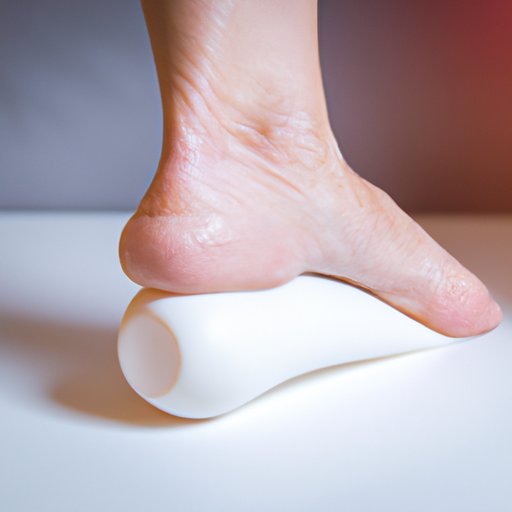
I. Introduction
If you’ve ever experienced a sharp pain in your foot first thing in the morning, chances are you know what it feels like to have plantar fasciitis. It’s a common condition that occurs when the band of tissue that runs from your heel to your toes (the plantar fascia) becomes inflamed.
It’s estimated that 1 in 10 people will develop plantar fasciitis at some point in their lives, making it one of the most common foot conditions. But the good news is that there are plenty of ways to treat it. In this article, we’ll cover 10 effective home remedies, exercises, medical and alternative treatments, and lifestyle changes to help reduce your plantar fasciitis pain and get you back on your feet.
II. 10 Effective Home Remedies for Treating Plantar Fasciitis
1. Stretching: Stretching the plantar fascia and Achilles tendon can help reduce stiffness and pain. To do this, sit on the floor with your legs straight out in front of you. Wrap a towel or belt around the ball of your foot and gently pull back towards your body, holding the stretch for 30 seconds.
2. Foot massage: Massaging your feet can help to relieve tension and promote healing. Use a tennis ball or a frozen water bottle to massage the bottom of your foot for 5-10 minutes each day.
3. Ice the heel: Applying ice to the bottom of your foot can help to reduce inflammation. Freeze a water bottle and roll it along the bottom of your foot for 20 minutes each day.
4. Epsom salt soak: Soaking your feet in warm water with Epsom salt can help to reduce muscle pain and inflammation. Mix 1 cup of Epsom salt with warm water in a tub and soak your feet for 20-30 minutes.
5. Turmeric: Turmeric has anti-inflammatory properties that can help reduce pain and swelling. Mix a teaspoon of turmeric powder with water to make a paste, and apply it to the bottom of your foot for 20-30 minutes before rinsing it off.
6. Ginger tea: Drinking ginger tea can help to reduce inflammation throughout the body. Steep fresh ginger root in boiling water for 10-15 minutes, and drink it once it has cooled down.
7. Omega-3 supplements: Omega-3 fatty acids can help to reduce inflammation in the body. Take an omega-3 supplement or increase your intake of fatty fish, such as salmon or tuna.
8. Rest: Resting your foot is important for reducing inflammation. Avoid high-impact activities and try to keep weight off of your foot when possible.
9. Essential oils: Essential oils, such as lavender or peppermint, can help to reduce pain and inflammation. Mix a few drops with a carrier oil, such as coconut oil, and massage into the bottom of your foot.
10. Night splints: Wearing a night splint can help to keep your foot in a neutral position while you sleep, reducing morning pain. Talk to your doctor about which type of night splint is right for you.
III. The Best Exercises to Treat Plantar Fasciitis
1. Calf raises: Standing on the edge of a step with your heels hanging off, raise your body as high as you can on your toes, and then lower yourself back down. Repeat for 3 sets of 10-15 reps.
2. Toe curls: Place a small towel on the floor and use your toes to scrunch it up towards you. Repeat for 3 sets of 10-15 reps.
3. Heel dips: Standing facing a wall with your feet hip-width apart, place your hands on the wall at shoulder height. Step one foot back, keeping your heel on the ground, and lean into the wall until you feel a stretch in your calf. Hold for 30 seconds and then switch legs.
Before and after exercising, be sure to stretch your calf muscles and plantar fascia to reduce the risk of pain and injury.
IV. Lifestyle Changes to Reduce Plantar Fasciitis Pain
1. Properly fitting shoes: Make sure you’re wearing shoes that support your feet properly. Look for shoes with good arch support and a cushioned sole.
2. Avoid high-impact activities: High-impact activities, such as running and jumping, can exacerbate plantar fasciitis pain. Instead, opt for low-impact activities like swimming or biking.
3. Lose weight: Carrying extra weight can put added pressure on your feet, exacerbating plantar fasciitis pain. Talk to your doctor about a healthy weight loss plan if necessary.
4. Gradual increases in activity: Avoid sudden increases in physical activity that can put strain on your foot. Gradually increase your activity level to avoid injury.

V. Medical Treatments for Plantar Fasciitis: What You Need to Know
1. Orthotics: Custom-made shoe inserts can help to provide support and reduce inflammation in the foot. Talk to your doctor about whether orthotics are right for you.
2. Steroid injections: Injections of corticosteroids into the plantar fascia can help to reduce inflammation and pain. However, there is a risk of rupturing the plantar fascia with repeated injections.
3. Extracorporeal shock wave therapy (ESWT): Using sound waves, ESWT can help to stimulate healing in the plantar fascia. It’s a non-invasive procedure that requires no anesthesia.
4. Surgery: In severe cases, surgery may be necessary to release the tension in the plantar fascia. However, surgery should always be a last resort and is not always effective.
VI. Alternative Treatments for Plantar Fasciitis: Exploring Acupuncture and More
1. Acupuncture: Acupuncture uses small needles to stimulate certain points on the body, promoting healing and pain relief. Studies have shown that acupuncture can be an effective treatment for plantar fasciitis.
2. Massage therapy: Massage therapy can help to relieve tension in the foot and promote healing. Talk to a licensed massage therapist about techniques that can help with plantar fasciitis.
3. Chiropractic care: Chiropractic adjustments can help to align the bones in your foot and reduce tension on the plantar fascia.
VII. Preventing Plantar Fasciitis in the Future
1. Stretch and exercise regularly: Keeping your calf muscles and plantar fascia flexible and strong can help to prevent plantar fasciitis from returning.
2. Wear appropriate shoes: Make sure you’re wearing shoes that fit properly and provide adequate support for your feet.
3. Take breaks: If you’re standing or walking for long periods of time, take breaks to rest your feet and reduce the risk of injury.
VIII. Conclusion
Plantar fasciitis can be a painful and frustrating condition, but the good news is that there are plenty of ways to treat it. From natural remedies and exercises to medical and alternative treatments, and lifestyle changes, taking care of your feet can help reduce pain and promote healing.
Don’t let plantar fasciitis keep you down. Try some of the techniques discussed in this article and talk to your doctor about a treatment plan that’s right for you.




